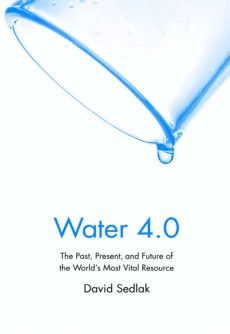
Water 4.0: The Past, Present, and Future of the World's Most Vital Resource
David L. Sedlak
288 pages, Yale University Press, 2014
If water supply is “the essential ingredient of civilization,” as David Sedlak contends in his book Water 4.0, why do most of us know so very little about how the water in our cities is retrieved, cleaned, distributed, and disposed of? Why do we know even less about the history behind the hard-won social and technological advancements that resulted in the water distribution systems that we rely on today?
Sedlak aims to remedy that gap in knowledge by recounting nearly 3,000 years of progress in water technology. He walks readers through each pivotal stage in the evolution of water infrastructure—from the achievement of effective water distribution on a citywide scale during the Roman era (Water 1.0) to the advancements in water treatment that enabled the delivery of safe drinking water in the fast-growing cities of the 19th century (Water 2.0) to the developments in sewage treatment that emerged during the 20th century to protect the larger water ecosystem (Water 3.0).
These evolutionary leaps represent social innovation at its very best. They exemplify how people and governments, working through an iterative process, can create vast systems that improve every aspect of life. Throughout Water 4.0, Sedlak pays homage to those he calls “unsung heroes”—to the scientists, engineers, public health experts, environmental activists, lawmakers, politicians, and city planners who have made our cities both livable and prosperous by reducing the epidemiological hazards associated with unsafe drinking water and sewage-choked waterways.
But the crux of the book lies in Sedlak’s exploration of the next stage in the evolution of water infrastructure: Water 4.0. In his estimation, the effort needed to sustain the cities of tomorrow will require an ambitious combination of innovative conservation techniques, serious improvements to centralized water systems, and experiments in adopting decentralized urban water systems—systems that exist locally, apart from the water grid as a whole.
The target audience for this book is people in developed countries who operate and use advanced treatment systems. These systems, although they are undergoing acute stresses caused by climate change and population growth, are able to meet the functional needs of present-day consumers. For this audience, Water 4.0 presents both a terrific synthesis of how we got where we are today and a solid overview of the steps that we should take next.
How, though, do we deal with the leap to Water 4.0 in countries that are still operating with (at best) Water 2.0 distribution technologies? I began writing this review while working in Kathmandu, Nepal, a city of more than two million people with a water system that can adequately serve only about 500,000 residents. Year after year, under pressure from a rapidly increasing urban population, the city’s water supply continues to degrade significantly in quality, quantity, and reliability.
Sedlak pays little attention to such communities in Water 4.0. Yet, as he points out, every advance between stages (from Water 1.0 to Water 2.0, and so on) has been the by-product of a profound crisis. “Quite often,” he writes, “the solution is developed on the front lines of battle—[in] the cities facing the toughest problems—and from there the solutions spread to the rest of the world.” The deepest forms of water-related crisis that most developed countries will face in the near term (tax hikes, higher utility bills) likely won’t be enough to incite the kind of action that Sedlak envisions. Instead, the next cycle of innovation may well originate in the developing countries that he overlooks.
The cities of tomorrow must have the resources to fund, operate, expand, maintain, and, when necessary, reinvent their water systems to meet the increasing demands of a growing number of customers. The strain that those customers will place on already taxed water utilities, let alone the nascent water systems in developing countries, should be of paramount concern to everyone.
Sedlak, a practicing engineer as well as a professor of civil and environmental engineering at the University of California, Berkeley, is well suited to lay out the history of water utility development. Yet the conflicting impulses of the professor, the engineer, and the environmentalist within Sedlak have led him to write a book that’s often uneven in tone. At times, the book flows easily, like a detective novel. At other times, it reads like a polemic by an aggrieved activist. And occasionally it drifts into hyper-technical, jargon-filled analysis. (I doubt that most readers will need to know the details of the “Streeter-Phelps dissolved oxygen sag curve.”) The variability in tone may cause readers to stumble as they make their way through the book, or even to abandon the book altogether. But they should stick with it.
Water, as Sedlak suggests, is the element that holds a city together and allows it to grow. Although the road signs that will lead us toward Water 4.0 may be hard to read now, Water 4.0 provides a useful map of where we have been—and of where we need to go.

